Commercial Law Assignment: Australian Consumer Law Analysis
VerifiedAdded on 2021/06/16
|9
|2866
|200
Homework Assignment
AI Summary
This assignment provides a comprehensive analysis of product liability within the framework of Australian commercial law. It begins by outlining the legal principles governing product liability, including the interplay of common law (specifically the tort of negligence) and legislation, such as the Australian Consumer Law (ACL). The assignment examines the duty of care manufacturers owe to consumers, referencing the landmark case of Donoghue v Stevenson and its impact on establishing negligence. It then explores the concept of damages caps in personal injury claims, discussing their purpose and the varying perspectives surrounding their fairness and effectiveness. Finally, the assignment delves into the specific provisions of the ACL related to manufacturer liability for safety defects, including the responsibilities of manufacturers and importers, and the avenues for consumers to seek redress. The document also highlights the importance of responsible business practices to mitigate product liability risks and summarizes key sections of the ACL relevant to consumer protection. The analysis includes the examination of various legal concepts, case studies, and provisions of the Australian Consumer Law.
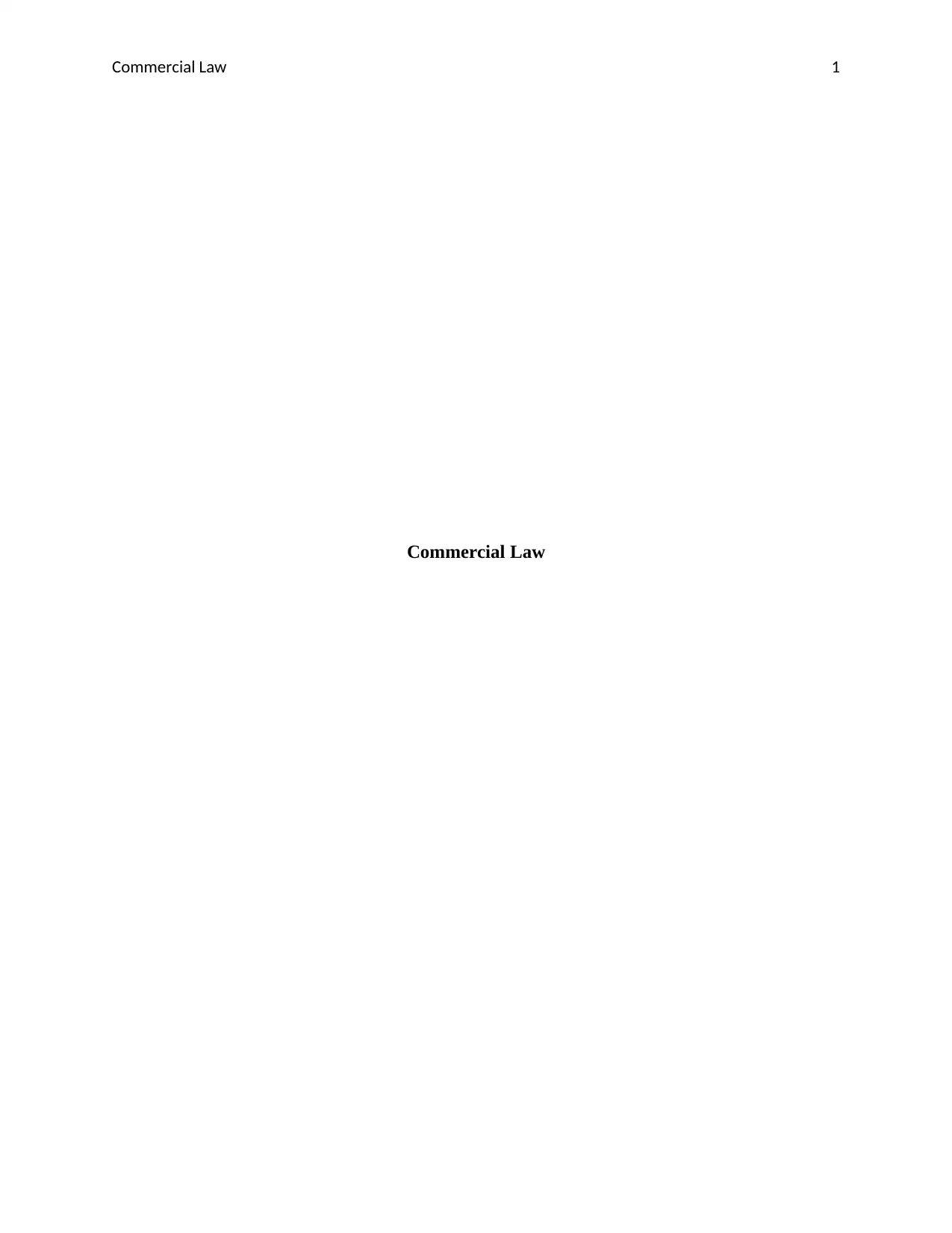
Commercial Law 1
Commercial Law
Commercial Law
Paraphrase This Document
Need a fresh take? Get an instant paraphrase of this document with our AI Paraphraser
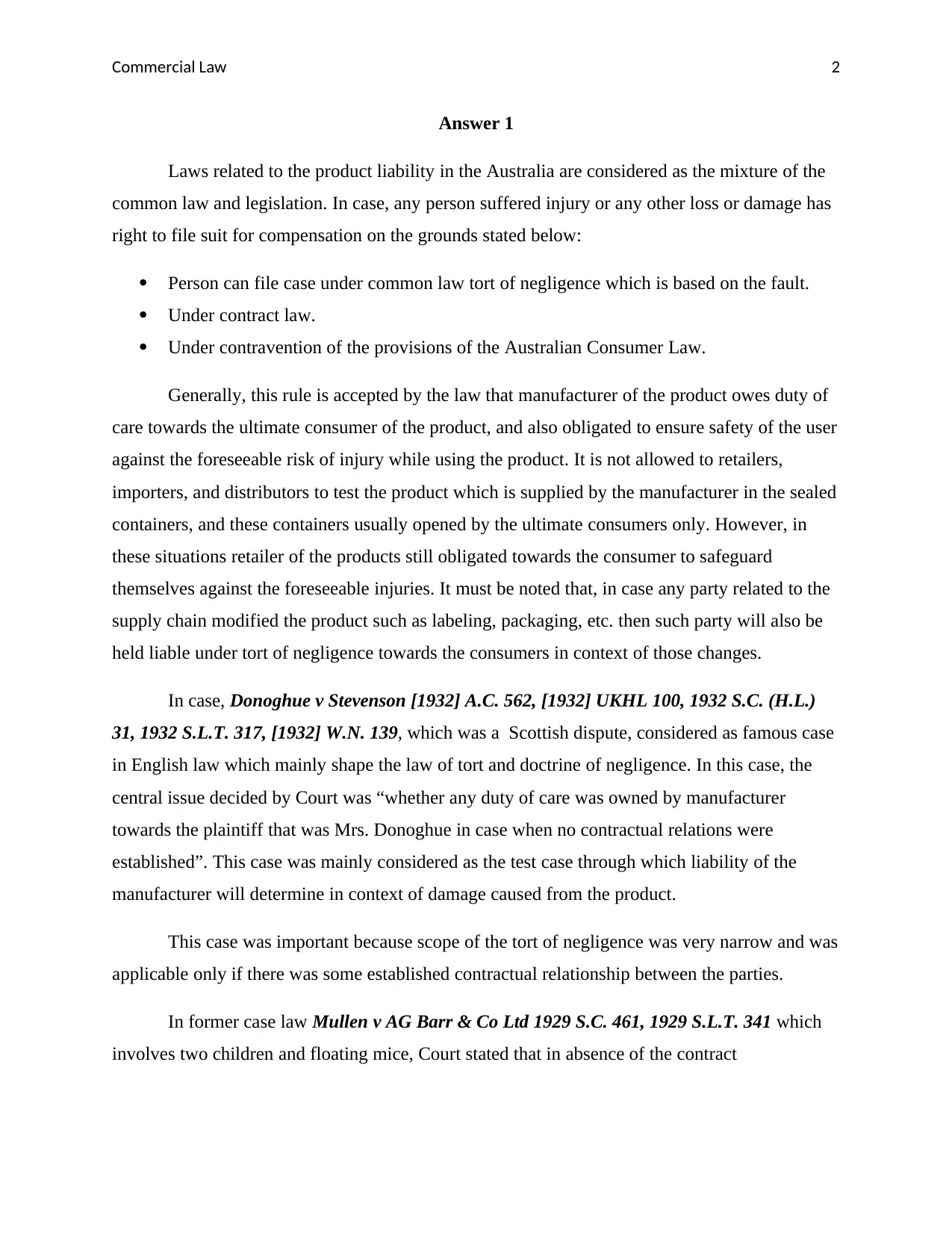
Commercial Law 2
Answer 1
Laws related to the product liability in the Australia are considered as the mixture of the
common law and legislation. In case, any person suffered injury or any other loss or damage has
right to file suit for compensation on the grounds stated below:
Person can file case under common law tort of negligence which is based on the fault.
Under contract law.
Under contravention of the provisions of the Australian Consumer Law.
Generally, this rule is accepted by the law that manufacturer of the product owes duty of
care towards the ultimate consumer of the product, and also obligated to ensure safety of the user
against the foreseeable risk of injury while using the product. It is not allowed to retailers,
importers, and distributors to test the product which is supplied by the manufacturer in the sealed
containers, and these containers usually opened by the ultimate consumers only. However, in
these situations retailer of the products still obligated towards the consumer to safeguard
themselves against the foreseeable injuries. It must be noted that, in case any party related to the
supply chain modified the product such as labeling, packaging, etc. then such party will also be
held liable under tort of negligence towards the consumers in context of those changes.
In case, Donoghue v Stevenson [1932] A.C. 562, [1932] UKHL 100, 1932 S.C. (H.L.)
31, 1932 S.L.T. 317, [1932] W.N. 139, which was a Scottish dispute, considered as famous case
in English law which mainly shape the law of tort and doctrine of negligence. In this case, the
central issue decided by Court was “whether any duty of care was owned by manufacturer
towards the plaintiff that was Mrs. Donoghue in case when no contractual relations were
established”. This case was mainly considered as the test case through which liability of the
manufacturer will determine in context of damage caused from the product.
This case was important because scope of the tort of negligence was very narrow and was
applicable only if there was some established contractual relationship between the parties.
In former case law Mullen v AG Barr & Co Ltd 1929 S.C. 461, 1929 S.L.T. 341 which
involves two children and floating mice, Court stated that in absence of the contract
Answer 1
Laws related to the product liability in the Australia are considered as the mixture of the
common law and legislation. In case, any person suffered injury or any other loss or damage has
right to file suit for compensation on the grounds stated below:
Person can file case under common law tort of negligence which is based on the fault.
Under contract law.
Under contravention of the provisions of the Australian Consumer Law.
Generally, this rule is accepted by the law that manufacturer of the product owes duty of
care towards the ultimate consumer of the product, and also obligated to ensure safety of the user
against the foreseeable risk of injury while using the product. It is not allowed to retailers,
importers, and distributors to test the product which is supplied by the manufacturer in the sealed
containers, and these containers usually opened by the ultimate consumers only. However, in
these situations retailer of the products still obligated towards the consumer to safeguard
themselves against the foreseeable injuries. It must be noted that, in case any party related to the
supply chain modified the product such as labeling, packaging, etc. then such party will also be
held liable under tort of negligence towards the consumers in context of those changes.
In case, Donoghue v Stevenson [1932] A.C. 562, [1932] UKHL 100, 1932 S.C. (H.L.)
31, 1932 S.L.T. 317, [1932] W.N. 139, which was a Scottish dispute, considered as famous case
in English law which mainly shape the law of tort and doctrine of negligence. In this case, the
central issue decided by Court was “whether any duty of care was owned by manufacturer
towards the plaintiff that was Mrs. Donoghue in case when no contractual relations were
established”. This case was mainly considered as the test case through which liability of the
manufacturer will determine in context of damage caused from the product.
This case was important because scope of the tort of negligence was very narrow and was
applicable only if there was some established contractual relationship between the parties.
In former case law Mullen v AG Barr & Co Ltd 1929 S.C. 461, 1929 S.L.T. 341 which
involves two children and floating mice, Court stated that in absence of the contract
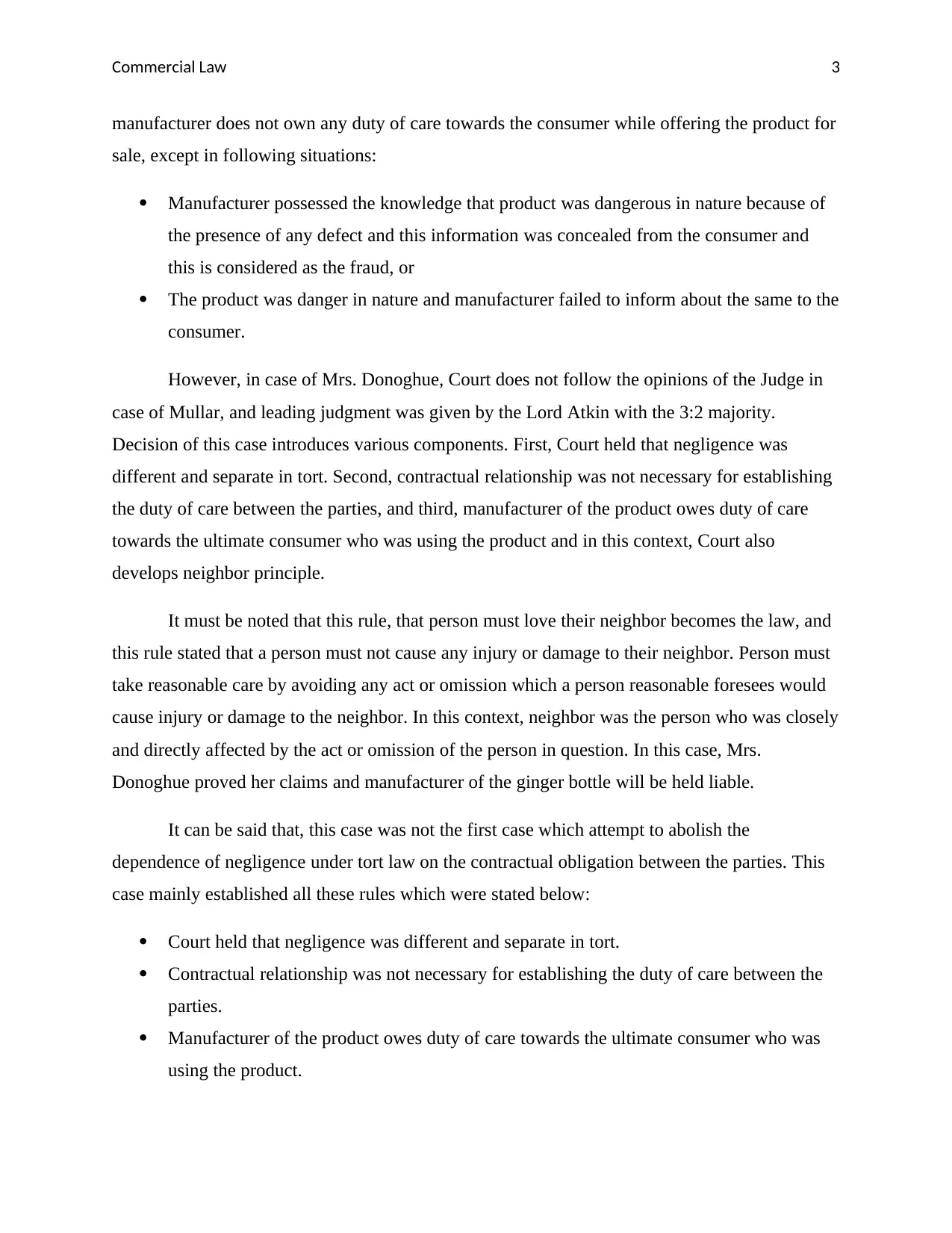
Commercial Law 3
manufacturer does not own any duty of care towards the consumer while offering the product for
sale, except in following situations:
Manufacturer possessed the knowledge that product was dangerous in nature because of
the presence of any defect and this information was concealed from the consumer and
this is considered as the fraud, or
The product was danger in nature and manufacturer failed to inform about the same to the
consumer.
However, in case of Mrs. Donoghue, Court does not follow the opinions of the Judge in
case of Mullar, and leading judgment was given by the Lord Atkin with the 3:2 majority.
Decision of this case introduces various components. First, Court held that negligence was
different and separate in tort. Second, contractual relationship was not necessary for establishing
the duty of care between the parties, and third, manufacturer of the product owes duty of care
towards the ultimate consumer who was using the product and in this context, Court also
develops neighbor principle.
It must be noted that this rule, that person must love their neighbor becomes the law, and
this rule stated that a person must not cause any injury or damage to their neighbor. Person must
take reasonable care by avoiding any act or omission which a person reasonable foresees would
cause injury or damage to the neighbor. In this context, neighbor was the person who was closely
and directly affected by the act or omission of the person in question. In this case, Mrs.
Donoghue proved her claims and manufacturer of the ginger bottle will be held liable.
It can be said that, this case was not the first case which attempt to abolish the
dependence of negligence under tort law on the contractual obligation between the parties. This
case mainly established all these rules which were stated below:
Court held that negligence was different and separate in tort.
Contractual relationship was not necessary for establishing the duty of care between the
parties.
Manufacturer of the product owes duty of care towards the ultimate consumer who was
using the product.
manufacturer does not own any duty of care towards the consumer while offering the product for
sale, except in following situations:
Manufacturer possessed the knowledge that product was dangerous in nature because of
the presence of any defect and this information was concealed from the consumer and
this is considered as the fraud, or
The product was danger in nature and manufacturer failed to inform about the same to the
consumer.
However, in case of Mrs. Donoghue, Court does not follow the opinions of the Judge in
case of Mullar, and leading judgment was given by the Lord Atkin with the 3:2 majority.
Decision of this case introduces various components. First, Court held that negligence was
different and separate in tort. Second, contractual relationship was not necessary for establishing
the duty of care between the parties, and third, manufacturer of the product owes duty of care
towards the ultimate consumer who was using the product and in this context, Court also
develops neighbor principle.
It must be noted that this rule, that person must love their neighbor becomes the law, and
this rule stated that a person must not cause any injury or damage to their neighbor. Person must
take reasonable care by avoiding any act or omission which a person reasonable foresees would
cause injury or damage to the neighbor. In this context, neighbor was the person who was closely
and directly affected by the act or omission of the person in question. In this case, Mrs.
Donoghue proved her claims and manufacturer of the ginger bottle will be held liable.
It can be said that, this case was not the first case which attempt to abolish the
dependence of negligence under tort law on the contractual obligation between the parties. This
case mainly established all these rules which were stated below:
Court held that negligence was different and separate in tort.
Contractual relationship was not necessary for establishing the duty of care between the
parties.
Manufacturer of the product owes duty of care towards the ultimate consumer who was
using the product.
⊘ This is a preview!⊘
Do you want full access?
Subscribe today to unlock all pages.

Trusted by 1+ million students worldwide
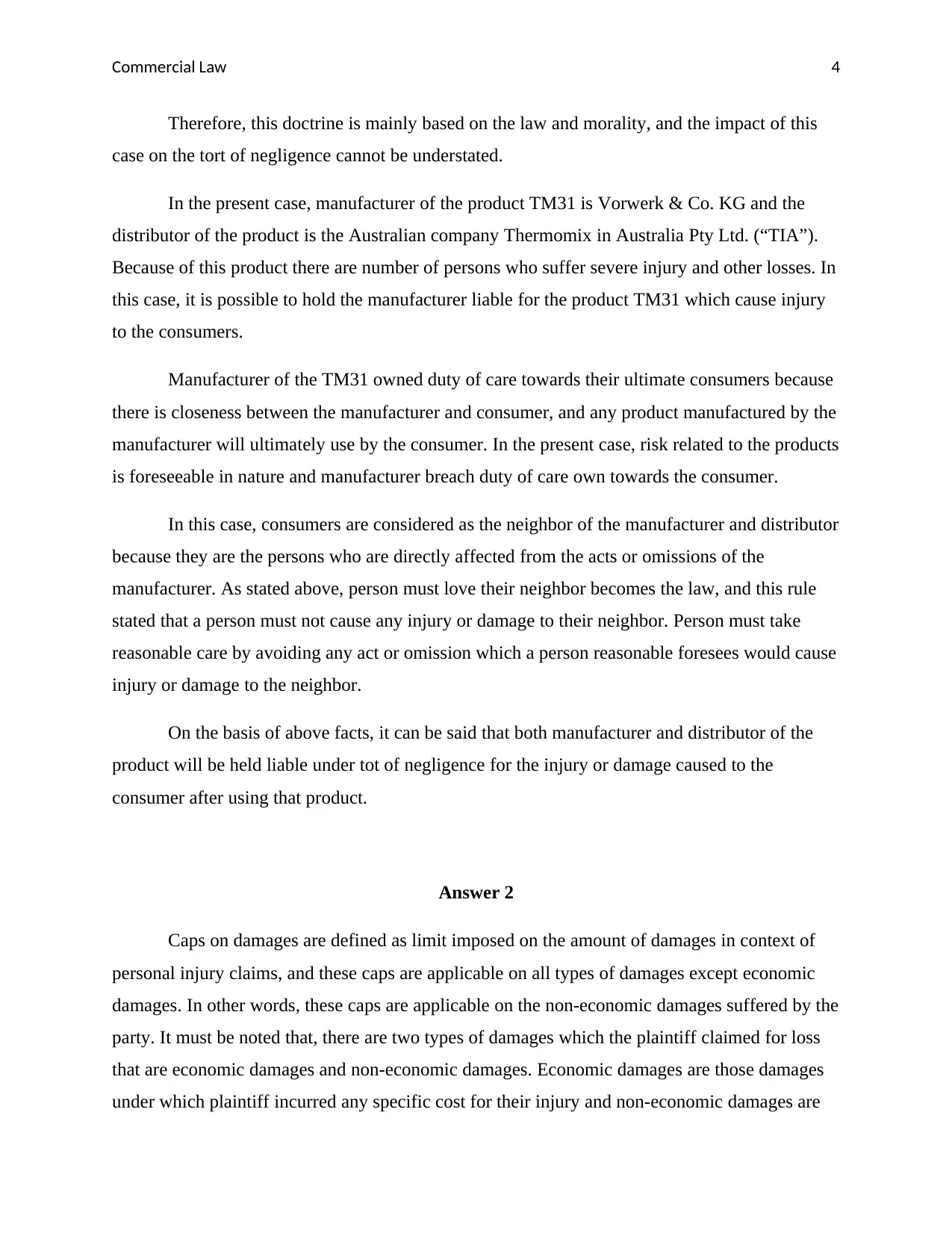
Commercial Law 4
Therefore, this doctrine is mainly based on the law and morality, and the impact of this
case on the tort of negligence cannot be understated.
In the present case, manufacturer of the product TM31 is Vorwerk & Co. KG and the
distributor of the product is the Australian company Thermomix in Australia Pty Ltd. (“TIA”).
Because of this product there are number of persons who suffer severe injury and other losses. In
this case, it is possible to hold the manufacturer liable for the product TM31 which cause injury
to the consumers.
Manufacturer of the TM31 owned duty of care towards their ultimate consumers because
there is closeness between the manufacturer and consumer, and any product manufactured by the
manufacturer will ultimately use by the consumer. In the present case, risk related to the products
is foreseeable in nature and manufacturer breach duty of care own towards the consumer.
In this case, consumers are considered as the neighbor of the manufacturer and distributor
because they are the persons who are directly affected from the acts or omissions of the
manufacturer. As stated above, person must love their neighbor becomes the law, and this rule
stated that a person must not cause any injury or damage to their neighbor. Person must take
reasonable care by avoiding any act or omission which a person reasonable foresees would cause
injury or damage to the neighbor.
On the basis of above facts, it can be said that both manufacturer and distributor of the
product will be held liable under tot of negligence for the injury or damage caused to the
consumer after using that product.
Answer 2
Caps on damages are defined as limit imposed on the amount of damages in context of
personal injury claims, and these caps are applicable on all types of damages except economic
damages. In other words, these caps are applicable on the non-economic damages suffered by the
party. It must be noted that, there are two types of damages which the plaintiff claimed for loss
that are economic damages and non-economic damages. Economic damages are those damages
under which plaintiff incurred any specific cost for their injury and non-economic damages are
Therefore, this doctrine is mainly based on the law and morality, and the impact of this
case on the tort of negligence cannot be understated.
In the present case, manufacturer of the product TM31 is Vorwerk & Co. KG and the
distributor of the product is the Australian company Thermomix in Australia Pty Ltd. (“TIA”).
Because of this product there are number of persons who suffer severe injury and other losses. In
this case, it is possible to hold the manufacturer liable for the product TM31 which cause injury
to the consumers.
Manufacturer of the TM31 owned duty of care towards their ultimate consumers because
there is closeness between the manufacturer and consumer, and any product manufactured by the
manufacturer will ultimately use by the consumer. In the present case, risk related to the products
is foreseeable in nature and manufacturer breach duty of care own towards the consumer.
In this case, consumers are considered as the neighbor of the manufacturer and distributor
because they are the persons who are directly affected from the acts or omissions of the
manufacturer. As stated above, person must love their neighbor becomes the law, and this rule
stated that a person must not cause any injury or damage to their neighbor. Person must take
reasonable care by avoiding any act or omission which a person reasonable foresees would cause
injury or damage to the neighbor.
On the basis of above facts, it can be said that both manufacturer and distributor of the
product will be held liable under tot of negligence for the injury or damage caused to the
consumer after using that product.
Answer 2
Caps on damages are defined as limit imposed on the amount of damages in context of
personal injury claims, and these caps are applicable on all types of damages except economic
damages. In other words, these caps are applicable on the non-economic damages suffered by the
party. It must be noted that, there are two types of damages which the plaintiff claimed for loss
that are economic damages and non-economic damages. Economic damages are those damages
under which plaintiff incurred any specific cost for their injury and non-economic damages are
Paraphrase This Document
Need a fresh take? Get an instant paraphrase of this document with our AI Paraphraser
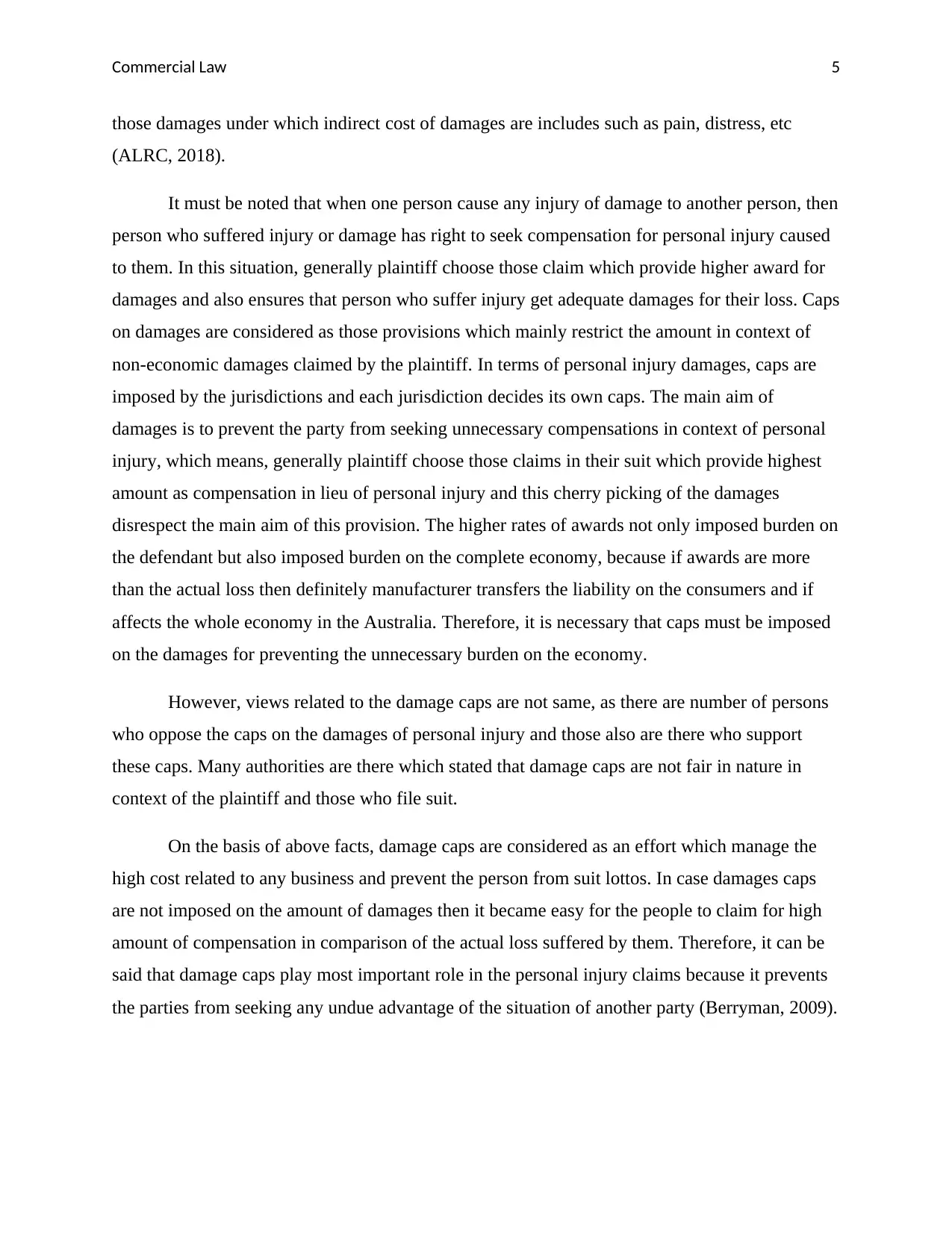
Commercial Law 5
those damages under which indirect cost of damages are includes such as pain, distress, etc
(ALRC, 2018).
It must be noted that when one person cause any injury of damage to another person, then
person who suffered injury or damage has right to seek compensation for personal injury caused
to them. In this situation, generally plaintiff choose those claim which provide higher award for
damages and also ensures that person who suffer injury get adequate damages for their loss. Caps
on damages are considered as those provisions which mainly restrict the amount in context of
non-economic damages claimed by the plaintiff. In terms of personal injury damages, caps are
imposed by the jurisdictions and each jurisdiction decides its own caps. The main aim of
damages is to prevent the party from seeking unnecessary compensations in context of personal
injury, which means, generally plaintiff choose those claims in their suit which provide highest
amount as compensation in lieu of personal injury and this cherry picking of the damages
disrespect the main aim of this provision. The higher rates of awards not only imposed burden on
the defendant but also imposed burden on the complete economy, because if awards are more
than the actual loss then definitely manufacturer transfers the liability on the consumers and if
affects the whole economy in the Australia. Therefore, it is necessary that caps must be imposed
on the damages for preventing the unnecessary burden on the economy.
However, views related to the damage caps are not same, as there are number of persons
who oppose the caps on the damages of personal injury and those also are there who support
these caps. Many authorities are there which stated that damage caps are not fair in nature in
context of the plaintiff and those who file suit.
On the basis of above facts, damage caps are considered as an effort which manage the
high cost related to any business and prevent the person from suit lottos. In case damages caps
are not imposed on the amount of damages then it became easy for the people to claim for high
amount of compensation in comparison of the actual loss suffered by them. Therefore, it can be
said that damage caps play most important role in the personal injury claims because it prevents
the parties from seeking any undue advantage of the situation of another party (Berryman, 2009).
those damages under which indirect cost of damages are includes such as pain, distress, etc
(ALRC, 2018).
It must be noted that when one person cause any injury of damage to another person, then
person who suffered injury or damage has right to seek compensation for personal injury caused
to them. In this situation, generally plaintiff choose those claim which provide higher award for
damages and also ensures that person who suffer injury get adequate damages for their loss. Caps
on damages are considered as those provisions which mainly restrict the amount in context of
non-economic damages claimed by the plaintiff. In terms of personal injury damages, caps are
imposed by the jurisdictions and each jurisdiction decides its own caps. The main aim of
damages is to prevent the party from seeking unnecessary compensations in context of personal
injury, which means, generally plaintiff choose those claims in their suit which provide highest
amount as compensation in lieu of personal injury and this cherry picking of the damages
disrespect the main aim of this provision. The higher rates of awards not only imposed burden on
the defendant but also imposed burden on the complete economy, because if awards are more
than the actual loss then definitely manufacturer transfers the liability on the consumers and if
affects the whole economy in the Australia. Therefore, it is necessary that caps must be imposed
on the damages for preventing the unnecessary burden on the economy.
However, views related to the damage caps are not same, as there are number of persons
who oppose the caps on the damages of personal injury and those also are there who support
these caps. Many authorities are there which stated that damage caps are not fair in nature in
context of the plaintiff and those who file suit.
On the basis of above facts, damage caps are considered as an effort which manage the
high cost related to any business and prevent the person from suit lottos. In case damages caps
are not imposed on the amount of damages then it became easy for the people to claim for high
amount of compensation in comparison of the actual loss suffered by them. Therefore, it can be
said that damage caps play most important role in the personal injury claims because it prevents
the parties from seeking any undue advantage of the situation of another party (Berryman, 2009).
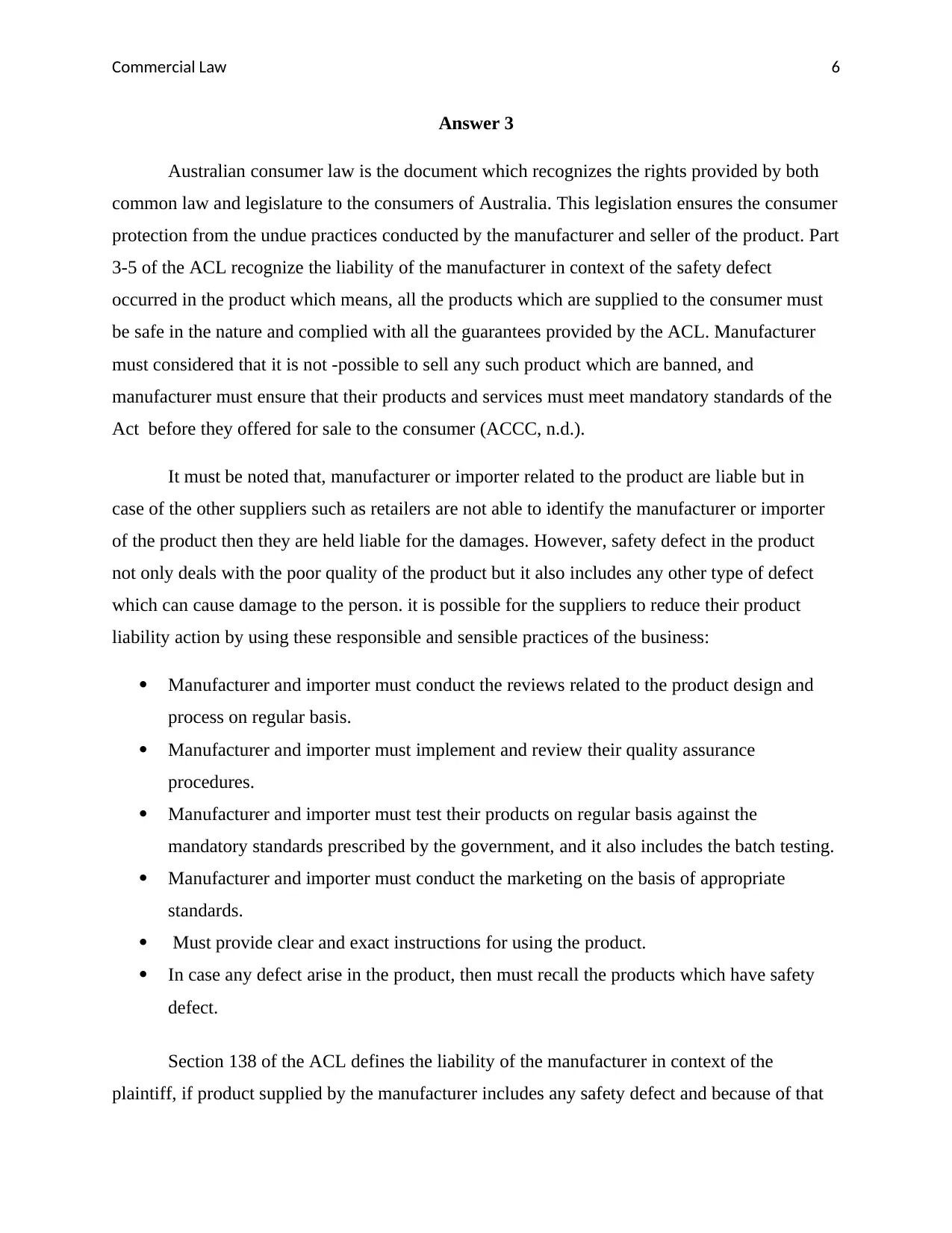
Commercial Law 6
Answer 3
Australian consumer law is the document which recognizes the rights provided by both
common law and legislature to the consumers of Australia. This legislation ensures the consumer
protection from the undue practices conducted by the manufacturer and seller of the product. Part
3-5 of the ACL recognize the liability of the manufacturer in context of the safety defect
occurred in the product which means, all the products which are supplied to the consumer must
be safe in the nature and complied with all the guarantees provided by the ACL. Manufacturer
must considered that it is not -possible to sell any such product which are banned, and
manufacturer must ensure that their products and services must meet mandatory standards of the
Act before they offered for sale to the consumer (ACCC, n.d.).
It must be noted that, manufacturer or importer related to the product are liable but in
case of the other suppliers such as retailers are not able to identify the manufacturer or importer
of the product then they are held liable for the damages. However, safety defect in the product
not only deals with the poor quality of the product but it also includes any other type of defect
which can cause damage to the person. it is possible for the suppliers to reduce their product
liability action by using these responsible and sensible practices of the business:
Manufacturer and importer must conduct the reviews related to the product design and
process on regular basis.
Manufacturer and importer must implement and review their quality assurance
procedures.
Manufacturer and importer must test their products on regular basis against the
mandatory standards prescribed by the government, and it also includes the batch testing.
Manufacturer and importer must conduct the marketing on the basis of appropriate
standards.
Must provide clear and exact instructions for using the product.
In case any defect arise in the product, then must recall the products which have safety
defect.
Section 138 of the ACL defines the liability of the manufacturer in context of the
plaintiff, if product supplied by the manufacturer includes any safety defect and because of that
Answer 3
Australian consumer law is the document which recognizes the rights provided by both
common law and legislature to the consumers of Australia. This legislation ensures the consumer
protection from the undue practices conducted by the manufacturer and seller of the product. Part
3-5 of the ACL recognize the liability of the manufacturer in context of the safety defect
occurred in the product which means, all the products which are supplied to the consumer must
be safe in the nature and complied with all the guarantees provided by the ACL. Manufacturer
must considered that it is not -possible to sell any such product which are banned, and
manufacturer must ensure that their products and services must meet mandatory standards of the
Act before they offered for sale to the consumer (ACCC, n.d.).
It must be noted that, manufacturer or importer related to the product are liable but in
case of the other suppliers such as retailers are not able to identify the manufacturer or importer
of the product then they are held liable for the damages. However, safety defect in the product
not only deals with the poor quality of the product but it also includes any other type of defect
which can cause damage to the person. it is possible for the suppliers to reduce their product
liability action by using these responsible and sensible practices of the business:
Manufacturer and importer must conduct the reviews related to the product design and
process on regular basis.
Manufacturer and importer must implement and review their quality assurance
procedures.
Manufacturer and importer must test their products on regular basis against the
mandatory standards prescribed by the government, and it also includes the batch testing.
Manufacturer and importer must conduct the marketing on the basis of appropriate
standards.
Must provide clear and exact instructions for using the product.
In case any defect arise in the product, then must recall the products which have safety
defect.
Section 138 of the ACL defines the liability of the manufacturer in context of the
plaintiff, if product supplied by the manufacturer includes any safety defect and because of that
⊘ This is a preview!⊘
Do you want full access?
Subscribe today to unlock all pages.

Trusted by 1+ million students worldwide
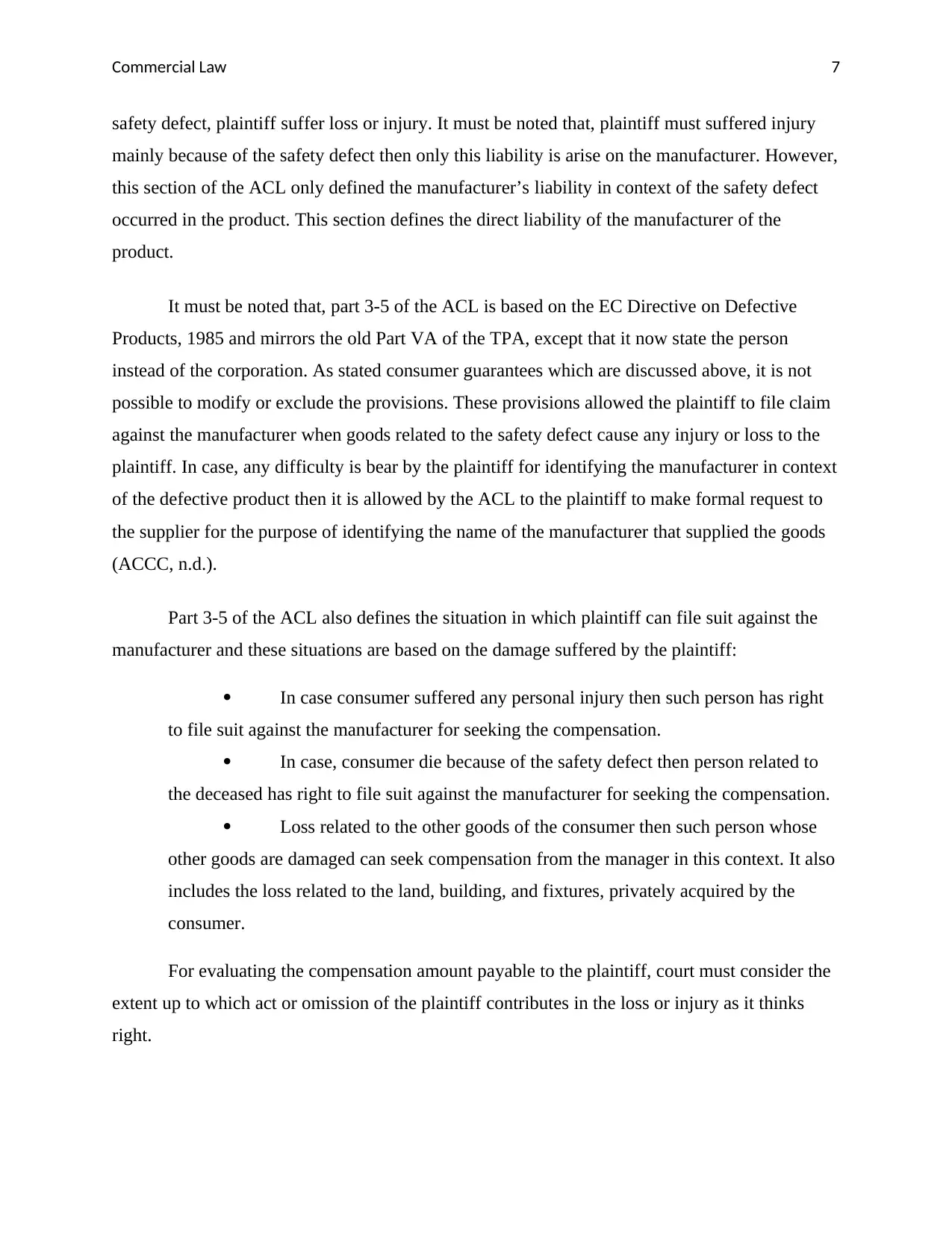
Commercial Law 7
safety defect, plaintiff suffer loss or injury. It must be noted that, plaintiff must suffered injury
mainly because of the safety defect then only this liability is arise on the manufacturer. However,
this section of the ACL only defined the manufacturer’s liability in context of the safety defect
occurred in the product. This section defines the direct liability of the manufacturer of the
product.
It must be noted that, part 3-5 of the ACL is based on the EC Directive on Defective
Products, 1985 and mirrors the old Part VA of the TPA, except that it now state the person
instead of the corporation. As stated consumer guarantees which are discussed above, it is not
possible to modify or exclude the provisions. These provisions allowed the plaintiff to file claim
against the manufacturer when goods related to the safety defect cause any injury or loss to the
plaintiff. In case, any difficulty is bear by the plaintiff for identifying the manufacturer in context
of the defective product then it is allowed by the ACL to the plaintiff to make formal request to
the supplier for the purpose of identifying the name of the manufacturer that supplied the goods
(ACCC, n.d.).
Part 3-5 of the ACL also defines the situation in which plaintiff can file suit against the
manufacturer and these situations are based on the damage suffered by the plaintiff:
In case consumer suffered any personal injury then such person has right
to file suit against the manufacturer for seeking the compensation.
In case, consumer die because of the safety defect then person related to
the deceased has right to file suit against the manufacturer for seeking the compensation.
Loss related to the other goods of the consumer then such person whose
other goods are damaged can seek compensation from the manager in this context. It also
includes the loss related to the land, building, and fixtures, privately acquired by the
consumer.
For evaluating the compensation amount payable to the plaintiff, court must consider the
extent up to which act or omission of the plaintiff contributes in the loss or injury as it thinks
right.
safety defect, plaintiff suffer loss or injury. It must be noted that, plaintiff must suffered injury
mainly because of the safety defect then only this liability is arise on the manufacturer. However,
this section of the ACL only defined the manufacturer’s liability in context of the safety defect
occurred in the product. This section defines the direct liability of the manufacturer of the
product.
It must be noted that, part 3-5 of the ACL is based on the EC Directive on Defective
Products, 1985 and mirrors the old Part VA of the TPA, except that it now state the person
instead of the corporation. As stated consumer guarantees which are discussed above, it is not
possible to modify or exclude the provisions. These provisions allowed the plaintiff to file claim
against the manufacturer when goods related to the safety defect cause any injury or loss to the
plaintiff. In case, any difficulty is bear by the plaintiff for identifying the manufacturer in context
of the defective product then it is allowed by the ACL to the plaintiff to make formal request to
the supplier for the purpose of identifying the name of the manufacturer that supplied the goods
(ACCC, n.d.).
Part 3-5 of the ACL also defines the situation in which plaintiff can file suit against the
manufacturer and these situations are based on the damage suffered by the plaintiff:
In case consumer suffered any personal injury then such person has right
to file suit against the manufacturer for seeking the compensation.
In case, consumer die because of the safety defect then person related to
the deceased has right to file suit against the manufacturer for seeking the compensation.
Loss related to the other goods of the consumer then such person whose
other goods are damaged can seek compensation from the manager in this context. It also
includes the loss related to the land, building, and fixtures, privately acquired by the
consumer.
For evaluating the compensation amount payable to the plaintiff, court must consider the
extent up to which act or omission of the plaintiff contributes in the loss or injury as it thinks
right.
Paraphrase This Document
Need a fresh take? Get an instant paraphrase of this document with our AI Paraphraser
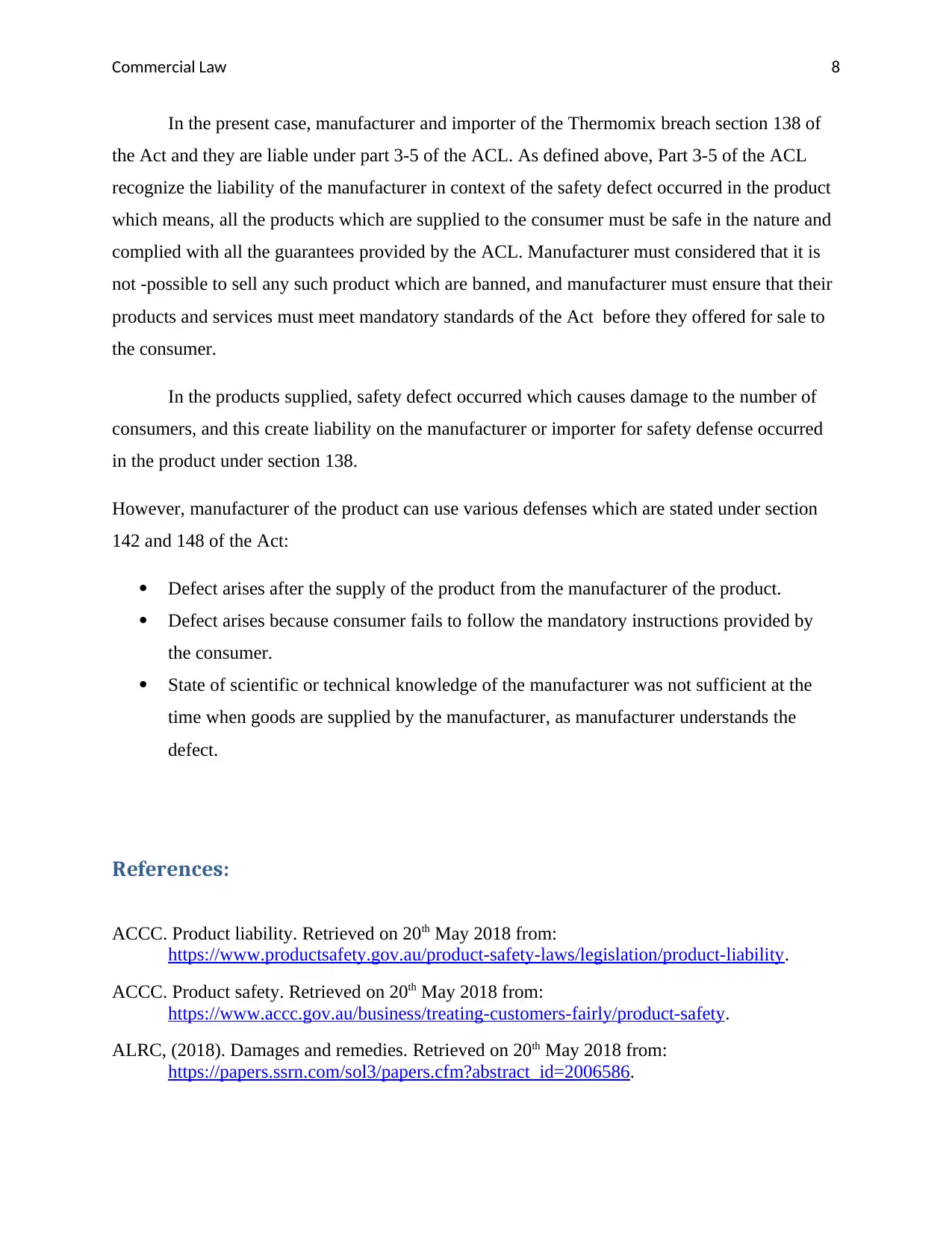
Commercial Law 8
In the present case, manufacturer and importer of the Thermomix breach section 138 of
the Act and they are liable under part 3-5 of the ACL. As defined above, Part 3-5 of the ACL
recognize the liability of the manufacturer in context of the safety defect occurred in the product
which means, all the products which are supplied to the consumer must be safe in the nature and
complied with all the guarantees provided by the ACL. Manufacturer must considered that it is
not -possible to sell any such product which are banned, and manufacturer must ensure that their
products and services must meet mandatory standards of the Act before they offered for sale to
the consumer.
In the products supplied, safety defect occurred which causes damage to the number of
consumers, and this create liability on the manufacturer or importer for safety defense occurred
in the product under section 138.
However, manufacturer of the product can use various defenses which are stated under section
142 and 148 of the Act:
Defect arises after the supply of the product from the manufacturer of the product.
Defect arises because consumer fails to follow the mandatory instructions provided by
the consumer.
State of scientific or technical knowledge of the manufacturer was not sufficient at the
time when goods are supplied by the manufacturer, as manufacturer understands the
defect.
References:
ACCC. Product liability. Retrieved on 20th May 2018 from:
https://www.productsafety.gov.au/product-safety-laws/legislation/product-liability.
ACCC. Product safety. Retrieved on 20th May 2018 from:
https://www.accc.gov.au/business/treating-customers-fairly/product-safety.
ALRC, (2018). Damages and remedies. Retrieved on 20th May 2018 from:
https://papers.ssrn.com/sol3/papers.cfm?abstract_id=2006586.
In the present case, manufacturer and importer of the Thermomix breach section 138 of
the Act and they are liable under part 3-5 of the ACL. As defined above, Part 3-5 of the ACL
recognize the liability of the manufacturer in context of the safety defect occurred in the product
which means, all the products which are supplied to the consumer must be safe in the nature and
complied with all the guarantees provided by the ACL. Manufacturer must considered that it is
not -possible to sell any such product which are banned, and manufacturer must ensure that their
products and services must meet mandatory standards of the Act before they offered for sale to
the consumer.
In the products supplied, safety defect occurred which causes damage to the number of
consumers, and this create liability on the manufacturer or importer for safety defense occurred
in the product under section 138.
However, manufacturer of the product can use various defenses which are stated under section
142 and 148 of the Act:
Defect arises after the supply of the product from the manufacturer of the product.
Defect arises because consumer fails to follow the mandatory instructions provided by
the consumer.
State of scientific or technical knowledge of the manufacturer was not sufficient at the
time when goods are supplied by the manufacturer, as manufacturer understands the
defect.
References:
ACCC. Product liability. Retrieved on 20th May 2018 from:
https://www.productsafety.gov.au/product-safety-laws/legislation/product-liability.
ACCC. Product safety. Retrieved on 20th May 2018 from:
https://www.accc.gov.au/business/treating-customers-fairly/product-safety.
ALRC, (2018). Damages and remedies. Retrieved on 20th May 2018 from:
https://papers.ssrn.com/sol3/papers.cfm?abstract_id=2006586.
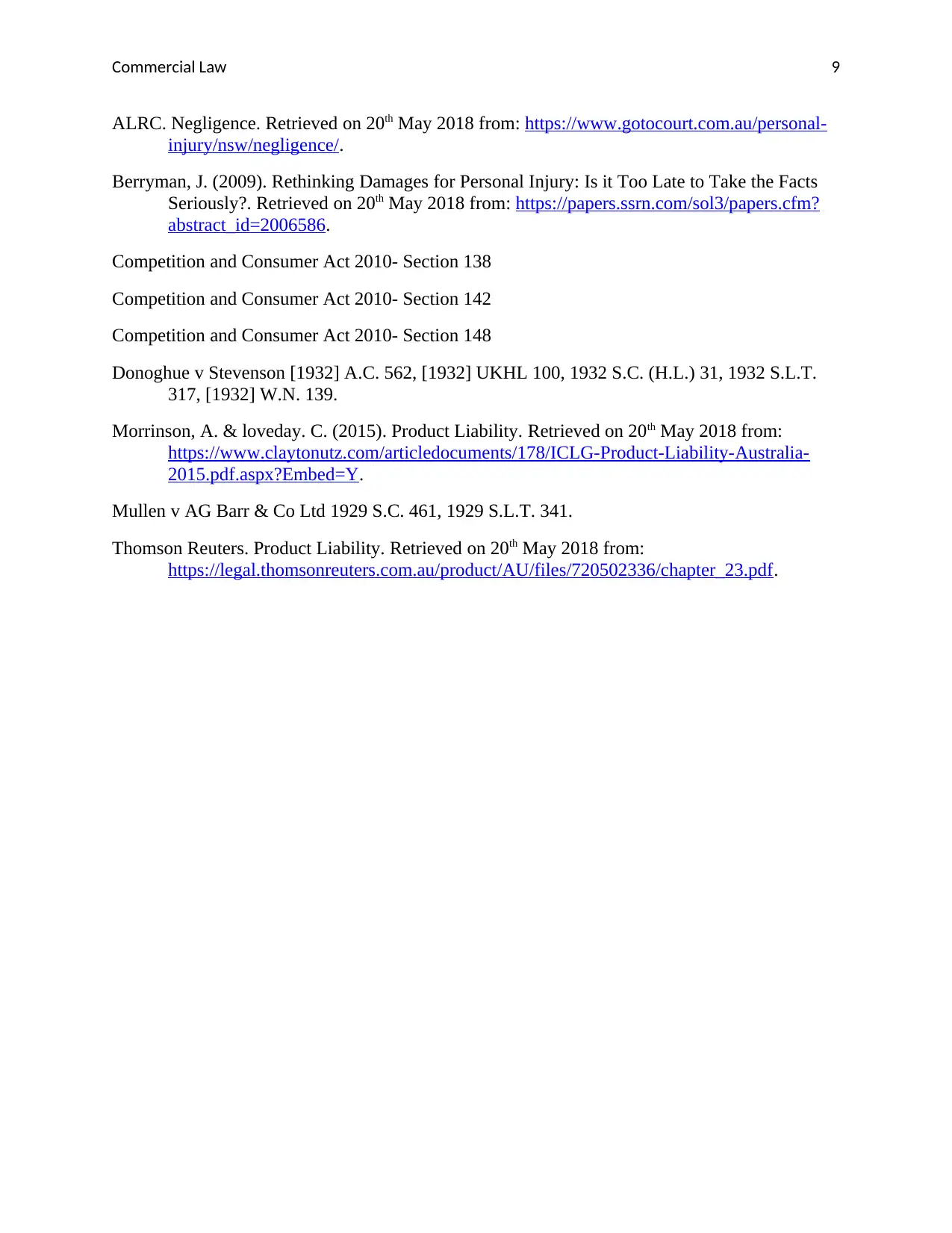
Commercial Law 9
ALRC. Negligence. Retrieved on 20th May 2018 from: https://www.gotocourt.com.au/personal-
injury/nsw/negligence/.
Berryman, J. (2009). Rethinking Damages for Personal Injury: Is it Too Late to Take the Facts
Seriously?. Retrieved on 20th May 2018 from: https://papers.ssrn.com/sol3/papers.cfm?
abstract_id=2006586.
Competition and Consumer Act 2010- Section 138
Competition and Consumer Act 2010- Section 142
Competition and Consumer Act 2010- Section 148
Donoghue v Stevenson [1932] A.C. 562, [1932] UKHL 100, 1932 S.C. (H.L.) 31, 1932 S.L.T.
317, [1932] W.N. 139.
Morrinson, A. & loveday. C. (2015). Product Liability. Retrieved on 20th May 2018 from:
https://www.claytonutz.com/articledocuments/178/ICLG-Product-Liability-Australia-
2015.pdf.aspx?Embed=Y.
Mullen v AG Barr & Co Ltd 1929 S.C. 461, 1929 S.L.T. 341.
Thomson Reuters. Product Liability. Retrieved on 20th May 2018 from:
https://legal.thomsonreuters.com.au/product/AU/files/720502336/chapter_23.pdf.
ALRC. Negligence. Retrieved on 20th May 2018 from: https://www.gotocourt.com.au/personal-
injury/nsw/negligence/.
Berryman, J. (2009). Rethinking Damages for Personal Injury: Is it Too Late to Take the Facts
Seriously?. Retrieved on 20th May 2018 from: https://papers.ssrn.com/sol3/papers.cfm?
abstract_id=2006586.
Competition and Consumer Act 2010- Section 138
Competition and Consumer Act 2010- Section 142
Competition and Consumer Act 2010- Section 148
Donoghue v Stevenson [1932] A.C. 562, [1932] UKHL 100, 1932 S.C. (H.L.) 31, 1932 S.L.T.
317, [1932] W.N. 139.
Morrinson, A. & loveday. C. (2015). Product Liability. Retrieved on 20th May 2018 from:
https://www.claytonutz.com/articledocuments/178/ICLG-Product-Liability-Australia-
2015.pdf.aspx?Embed=Y.
Mullen v AG Barr & Co Ltd 1929 S.C. 461, 1929 S.L.T. 341.
Thomson Reuters. Product Liability. Retrieved on 20th May 2018 from:
https://legal.thomsonreuters.com.au/product/AU/files/720502336/chapter_23.pdf.
⊘ This is a preview!⊘
Do you want full access?
Subscribe today to unlock all pages.

Trusted by 1+ million students worldwide
1 out of 9
Related Documents
Your All-in-One AI-Powered Toolkit for Academic Success.
+13062052269
info@desklib.com
Available 24*7 on WhatsApp / Email
![[object Object]](/_next/static/media/star-bottom.7253800d.svg)
Unlock your academic potential
Copyright © 2020–2025 A2Z Services. All Rights Reserved. Developed and managed by ZUCOL.





